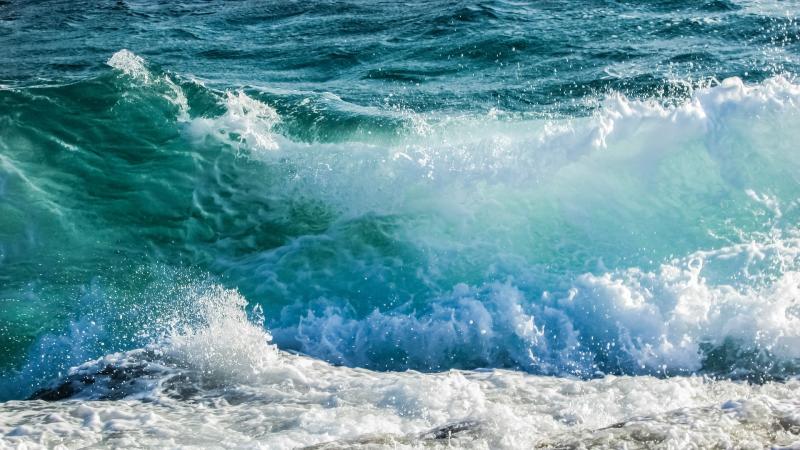
Image: Credit Pixabay
Researchers from the Indian Institute of Technology Bombay analysed wave data from coastal regions of India to inform choices of location and strategies for setting up wave energy plants. They studied wave data over four decades from the exclusive economic zone (the area of the sea over which a nation-state has the right to access marine resources) of mainland India and islands of Lakshadweep and Andaman and Nicobar to understand the variations in wave power across locations and seasons. The researchers published a report about this in the journal Regional Studies in Marine Science.
Increasing the use of renewable energy sources is essential as the threat of climate change escalates. However, the potential of not all renewable sources of energy is equally explored. Hydroelectric projects account for 70% of the power generated from renewable sources and 16.6% of the world's total electricity production. Wind and solar energy plants are gradually increasing too. Among the renewable sources, energy from the ocean appears to be the least explored, in spite of its abundant availability.
Good estimates of power that can be generated using wave energy along the coastline are missing in countries like India, due largely to the practical challenges in collecting in-situ data on ocean energy resources.
“The vast coastal length, varying dynamics, geography, patterns and characteristics of waves with seasons and locations, difficulty in on-site measurements and difficulties in assessing environmental impacts are few factors that make assessing energy potential difficult,” says Prof Balaji Ramakrishnan, who led the IIT Bombay study.
Research scholars Ankita Misra and Satheeshkumar Jeyaraj, and a former summer intern, Haripriya R, carried out the current study under the guidance of Prof. Balaji Ramakrishnan at the Civil Engineering department of IIT Bombay. The lab headed by Prof. Balaji has been working on marine renewable energy sources like waves, tides and currents for about a decade now.
Wave energy can be converted to electricity using floating devices (point absorber buoys) or fixed devices such as turbines. For any type of device, the energy they harvest from an incoming wave is proportional to the height of the wave (technically called significant wave height) and its time period (the time it takes for a wave to pass a point). It is essential for the researchers to estimate these parameters, so as to calculate the wave power availability.
Prof. Balaji’s team used wave data for India’s coastline for 39 years, made available by ECMWF (European Centre for Medium-Range Weather Forecasts). They analysed the data to understand significant wave height (SWH) and wave power (WP) variations across seasons and locations. Understanding the variations in these parameters can help minimise fluctuations in the output power and ensure a steady supply by choosing locations with fewer variations. “In addition, it is observed that many proven energy extracting technologies perform well beyond certain threshold ranges of wave power and significant wave height,” adds Prof. Balaji, further emphasizing on the importance of understanding these parameters in choosing appropriate technologies as well as the locations to install them.
Using mathematical modelling simulations of ocean dynamics and extensive analysis of wave data collected over decades, the team tried to identify places where the wave energy plants may potentially be established. They also estimated the seasonal variations of these ocean dynamics that are crucial to making policy decisions.
The study showed that the southern tip of mainland India with high levels of wave power and lesser variations is best suited to set up wave energy plants. Availability of wave power is strongly seasonal in the majority of regions along the Indian coastline, with highest during the monsoon months. Since solar energy is abundant during non-monsoon months, the study suggests that a strategy that combines solar and wind power in the corresponding seasons can ensure a continuous supply of sustainable energy for the entire country.
The study also identifies locations along the coastlines of Lakshadweep and Andaman and Nicobar islands with significant wave power values which can possibly be tapped to meet the local energy requirements of these individual isolated islands. These islands are currently dependent on the mainland for fuel supply, leading to severe power shortages. A switch to sustainable and possibly low-cost wave power can reduce the islands’ dependency on the mainland and contribute towards improving the living standards.
“Several habited islands of Andaman and Lakshadweep bank on fossil-fuel-based electricity generation. As the islands are isolated and scattered, catering them with power-grids will be challenging and economically not viable,” says Prof. Balaji.
His team’s work can potentially help identify appropriate marine renewable energy resources in the vicinity of individual islands and adopt suitable technologies to serve the minimal electricity requirements.
The knowledge gained through this IIT Bombay study can help narrow down the focus of future studies by indicating possible locations for power plants. The assessment of wave energy potential is a necessary first step towards setting up large scale wave power plants. More detailed estimation of available marine energy, investigation of feasible and optimal technologies, innovating Indian-condition-specific devices, data collections to ascertain the estimates and thorough analysis of potential environmental impact are the necessary immediate steps towards the journey to actualise the potential of wave energy according to Prof. Balaji.
This article has been run past the researchers, whose work is covered, to ensure accuracy.






